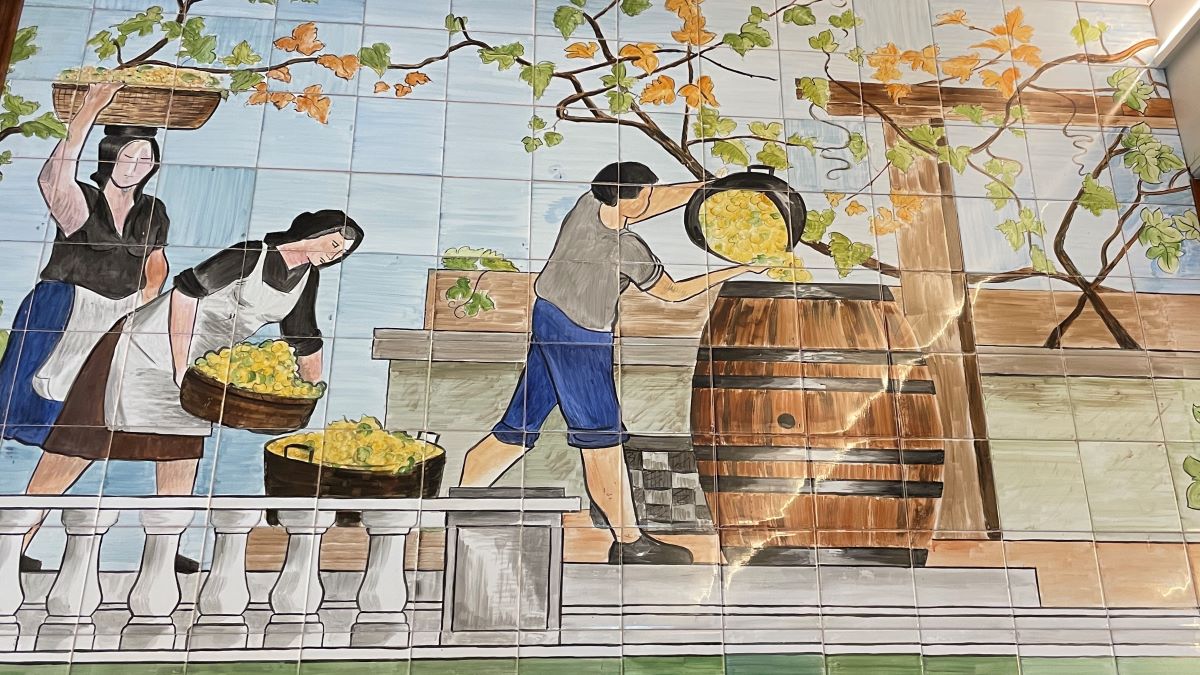“Green Spain” is where savvy Europeans head out to escape extreme heat during summer months.
The lush, green landscape of Galicia in NW Spain is enhanced by the ubiquitous vineyards of Rías Baixas, who produce one of Spain’s most famous white wines. You’ll find the manor houses of past nobility displaying art and cultural history of the period. There is also a backstory of small families who toil, working the soil and growing grapes, always with uncertainty of the outcomes and paybacks for their efforts. The region has been compared to Sancerre in the Loire Valley, Marlborough on the South Island of New Zealand, the Rhine in Germany, and the Finger Lakes wine country of upstate New York.
The Albariño grape variety flourishes here on hillsides cooled by coastal breezes, as well as in adjacent northern Portugal, where it’s known as Alvarinho. This is the predominant location for this specific grape whose characteristics can be described as light to medium bodied with characteristics of citrus or stone fruit with a hint of salinity due to its maritime location, high acidity and low alcohol. Albariño is an ideal sipping wine and also a versatile food friendly white wine that pairs particularly well with seafood.
I’m visiting to flesh out for myself what author and editor Greig Santos-Buch posed in his 2023 Travel Guide – Are the white wines from Rías Baixas as iconic as the reds from Rioja? – Let’s find out.
RELATED: Wine Pairing Guide: Tips For Pairing Wine with All Kinds of Food
Travel Tips and Getting Around
You can fly or take the Renfe train from Madrid to Santiago de Compostela, rent a vehicle and head south to Rías Baixas (RB) in about one hour. The drive from Porto is only 3 to 4 hours. The six-hour drive west from Bilbao is easy and relaxed on Highway 8. Head for Cambados, which is the main production center for Albariño in RB, and where I stationed myself. It’s an easy and relaxed arrival and an unhurried place to explore. I rented an AirBnB and easily walked into town. There are also hotels and the Parador de Cambados, a beautifully situated historic stone hotel situated across from the waterfront.
The Winetraveler Guides are always the best source for wine country travel planning. You can also reference the Rias Baixas Wineries Association and Ruta de Vinos Tourism Board websites.
RECOMMENDED: Book a Rías Baixas Private Tour with Wine Tasing, Food, Boat and Pickup with Tours of Galicia
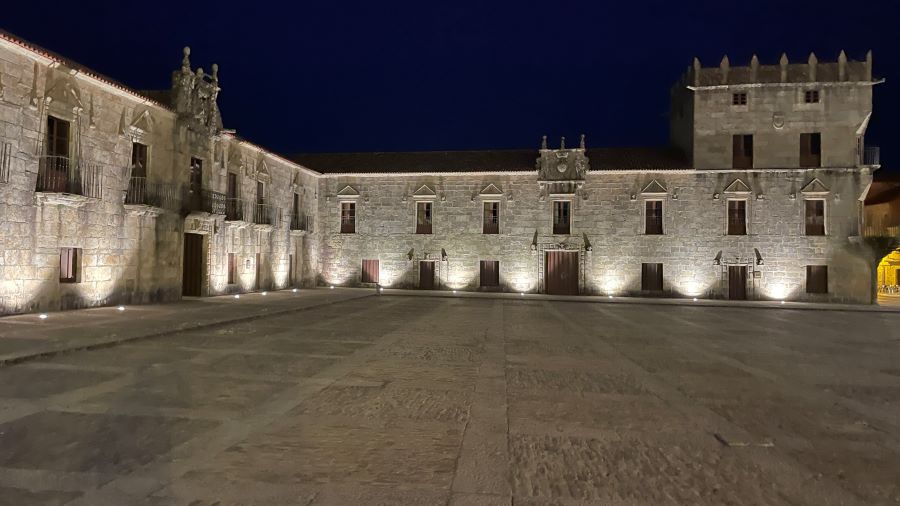
History of the Rías Baixas Wine Region
Rías Baixas is the birthplace of Albariño which comprises 95% of all vines planted here. This is a fascinating setting with multitudes of micro-plot farmers hand picking over 20,000 individual parcels, and constantly seeking local markets for their fruit, while producers pursue new markets for their wines.
Romans reportedly planted grapes on the terraced slopes of the Mino and Sil rivers over 2,000 years ago. The area was later settled by Celtic travelers in the fifth and sixth century BC, and retains a sort of Celtic sensibility. I recall hearing the signature sounds of the Gallego language which seemed like a mashup of Irish and Portugués (their proximate border neighbor to the south). Later, in the 12th century, legend has it that Cluny pilgrims and monks traveling from the Rhine River along the Camino de Santiago brought vine cuttings and introduced Albarino into the region. Today there are over 5,000 farmers growing grapes on these small plots. Many claim 200-300 years of family farming history. They typically sell the fruit of their labors to the large producers: cooperatives like Martin Codax and Paco y Lola, or wineries like Condes de Alberei.
Albariño was not introduced into the U.S. until the early 1990s and enjoyed exponential growth. It was an easy wine to embrace – crisp, fresh, citrusy and delicious – leading to widespread acceptance in the U.S., especially by consumers who enjoyed Sauvignon Blanc and Pinot Grigio.
Today there are an estimated 200 wineries in the RB D.O. (Denomination of Origin), with five sub regions along the various Rías or estuaries. The Rías Baixas D.O. requires at least 70% Albariño although many producers choose to use 100%.
The primary sub-region is Val do Salnés in the vicinity of Cambados and Pontevedra where I stayed. Producers there are required to make only Albariño wines, and must use 100% Albariño grapes if the wines are from the Salnés Valley. Other regions include Ribeira do Ulla, Soutomaior, O Rosal, and Condado do Tea. Each area expresses the Albariño grape differently, but all share similar climate and terroir – cool, wet, and sunny with proximity to the North Atlantic, and granite soils that promote acidity and minerality. Albariño wines are as inherent to the people of Rías Baixas as they are to Galicia.
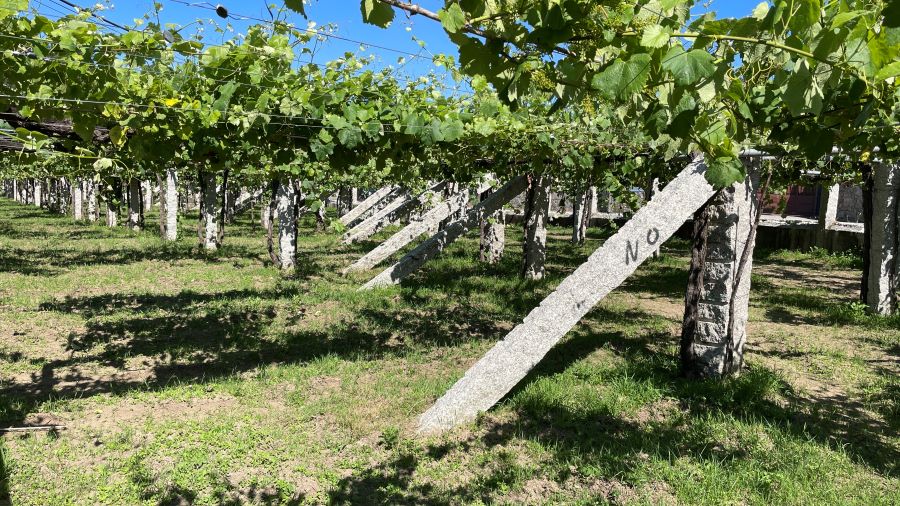
Albariño Wines
I loved walking under the grape pergolas here, and have never seen them utilized in grape growing like this. The pergolas system is elevated to about six feet to protect grape vines from water saturation and rotting roots, and to provide maximum aeration beneath the vines to prevent mildew. It’s a simple and practical trellising plan using locally available materials of large upright stone and granite pillars.
Val do Salnés or the Salnés Valley (Salty Valley) in Rías Baixas features crisp, dry, citrusy Albariño wines with pleasant acidity reminiscent of Viognier or Riesling. The minerality and salinity commonly experienced stand apart in Albariño wine here, and is derived from granitic soils and the marine climate.
I found a surprising diversity of styles and tastes from the Albariño wines I tasted. Treatments include the use of stainless steel for dry wines with steely acidity; lees stirring which induce a creaminess and fuller bodied wine; oak aging for complexity and aging potential; and concrete eggs and amphorae which impart their own minerality and clean finish.
Wine Touring Suggestions and Itinerary
Rías Baixas remains an intimate and somewhat remote wine region to visit. I recommend trying these wineries who I believe are among those most renowned for their Albariño expressions and the area’s rich viticultural heritage. I visited seven wineries, representative of a diverse range of makers from micro-boutique garagiste (garage) to Pazo (Galician Manor House) to mega-large cooperative producers.
Visitors are valued here and treated well with flexibility on tasting fees for buyers and easy access to stellar wines and intimate experiences. I recommend scheduling appointment for all visits, either online if available, or by phone or email well in advance.
Wineries and Wine Reviews Note – I am forgoing detailed wine descriptions and generally not reviewing specific wines for each of these wineries for a few reasons. There is primarily only one variety, Albariño, and all of the wines I tasted are from Salnes Valley, and all wineries recommended are producing very good to exceptional wines. You be the judge and decide your own palate preferences.
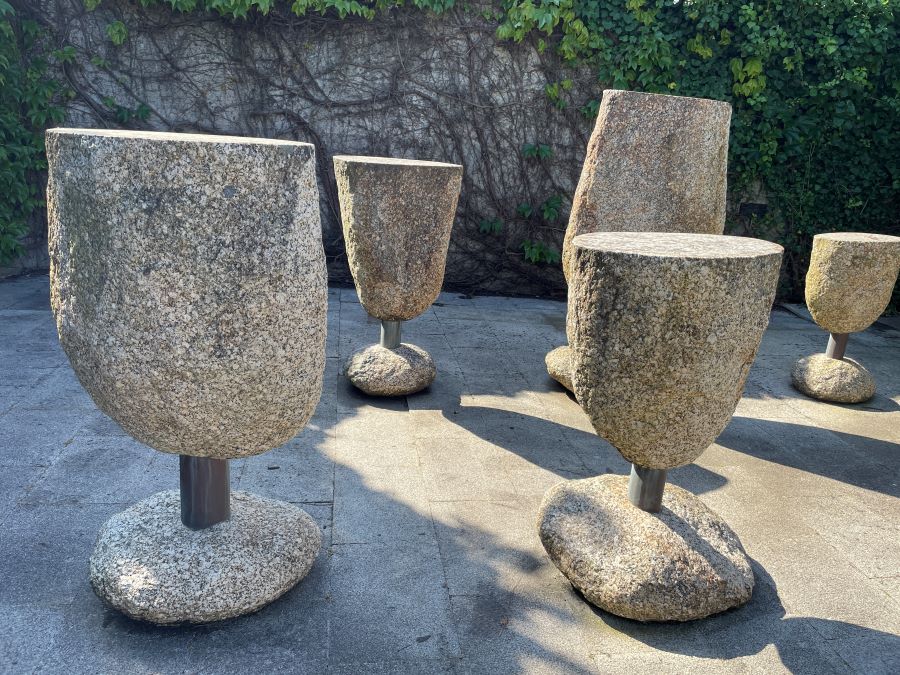
Sample Rías Baixas Itinerary
You will find winery descriptions and website links for the wineries I visited in the following section.
Day One
- 10am Constantina Sotelo
- 12pm Bodegas Granbazán tasting and lunch
- 3pm Paco y Lola
- 5pm Pazo Baión
Day Two
- 10:30 Cambados Wine Museum
- 11:30am Martin Codex
- 1:30pm Lunch downtown on the lovely Plaza Fefiñáns
- 2pm Bodegas del Palacio de Fefiñanes
- 4pm Pazo Senorans
Recommended Salnés Valley Wineries To Visit
Constantina Sotelo

What’s on Offer – The tasting room does not have official open hours, but you can easily visit by appointment only. Email David info@constantinasotelo.com for touring and tasting arrangements. Local cheese, crackers, and quince tapas are provided along with the tasting.
Founded in 1999, the family has been farming, growing and making wine for an estimated 200 years. Constantina Sotelo started commercial production under her label in 2010. She is one of many winemakers that are women in RB. Her son David Bugallo Sotelo showed me around, hosted a tasting and talked about the history of the winery. This is the micro boutique garagiste winery I mentioned previously. Five family members currently manage all growing and wine production for the brand.
In 2010 they converted to sustainable growing and “Natural” wine production, using nothing but oils and natural spray treatments of herbs and botanicals, and Sulphur as needed (to preserve freshness) in its vineyards and wines. They currently manage over 35 parcels and produce over 30 single parcel (vineyard block) wines. Breaking this down further – each of these wines come from a one single hectare (2.5 acres) parcel or plot – somehow managed and stored in two large garage size production areas which include many sized amphorae, concrete eggs, and neutral oak barrels. Total production is 2,000 cases and wines are available in eight U.S. states and internationally.
Wines – This is the place for you if you are an advocate or interested in natural wines, enjoy authentic real time experiences and supporting small family grower-producers – and all the wines you taste whether bottled or barrel samples are unique and interesting. My fav was the “Dama Xoana” Albariño.
Bodegas Granbazán



Images courtesy Carl Giavanti.
What’s on Offer – There are a variety of experiences on offer including tasting only, tour and tasting, and add food pairing to the above. 1.25 hour guided tours and tastings available by appointment Tuesday-Saturday by appointment. The tastings include tapas like mussels, and Galician cheeses and quince. There is also a full-service restaurant open Wednesday-Sunday, reservations suggested. This makes Bodegas Granbazán an ideal post morning extended stop for lunch and all the above.
RECOMMENDED: Book a Guided Tour of Bodegas Granbazán Today (Reserve now, Pay later)
Founded in 1981, the winery, surrounded by estate vineyards, produces about 40K cases and exports to the west coast, U.S. and internationally. It’s a stunning property and a tour reveals its decades of history. This is one of the many neo-classical manor houses previously mentioned and of itself is worth visiting. Granbazán is also philanthropic and supports local children through “AMICO”, a work program that employs children and people with disabilities and also participates in special Olympics programs.
Wines – Winemaker Diego Rias was named winemaker of 2023 and is consider a pioneer in modern winemaking. The winemaking team is producing a range of Albariño by innovating with technology and using modern winemaking practices, including the use of French oak for aging. All of the wines I tasted were exceptional and paired thoughtfully with our lunch courses which included mussels poached in salt water paired with the 2022 green label “etiqueta verde”; soft local cow cheese paired with the 2022 amber label “etiqueta ambar”; octopus with “Patatas de Galicia” with its own D.O. (Denomination of Origin) paired with 2020 Don Albaro de Bazan; and the 2020 Limousin which sits on lees unstirred for one year and is fermented eight months in French oak. My highest regards to the winemaking and kitchen teams.
Paco y Lolo

What’s on Offer – Guided tours and tastings are offered Monday-Friday at 11am, 1pm, 4pm in Spanish and English by appointment. The “Classic” one-hour tours conclude with tastings of three wines, and the “Gourmet” option includes a pairing of tinned fish, seafood or pate’ snacks.
Fondly known as the polka-dot winery, Paco y Lola was founded by growers in 2005, and is one of the newest and largest cooperatives with over 400 grower members. They organize over 200 hectares (500 acres) and work closely with families on 1,800 parcels of vineyards. The brand culture is one of respect for hundreds of years of grape growing tradition and introducing modern best practices, technologies and sustainability programs to its farmer partners. The winery has several sustainability certifications and is working to achieve the United Nations 2030 Sustainability Agenda.
To give you a sense of scale, they produce about 200K cases of wine, about the same size as the largest Willamette Valley producer. Wines – Paco y Lola winemaking is led by a team of women. The wines are widely distributed in the U.S. and nationally. The Albariño wines range from off to bone dry, and variations use extended lees, stainless steel and oak treatments. They also make a Brut sparkling wine, a white from the Mencia grape, and a red from Grenache and Tempranillo. These wines are very accessible and value priced for the export markets. Paco & Lola is a great wine to get your exploration of the Albariño grape started.
Pazo Baión
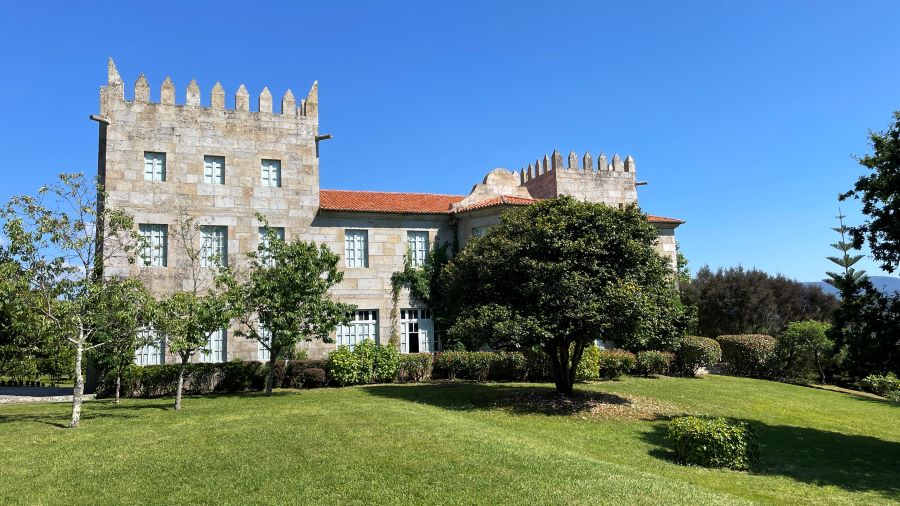
What’s on Offer – Four different historical tours and tastings are available daily except Sundays ranging from one to two hours. Check the website for details. Pazo Baión is a stunningly beautiful 75-acre manor house property worth touring, with several different historic buildings, old winery, granary, extensive pergolas, and an intact dovecote or pigeon house.
The manor house has established in the 16th century by the Lords of Sarmiento, descended from Celtic King Breogán who subdued the tribes of Galicia. Growing grapes was a thing, because soldiers and lords needed wine, so imagine its 500 years of vinous history. In the 1,900s Don Adoldo Fojo Silva purchased the property and farm of about 50 acres of estate vineyards. Many of the grapevines today are 50-70 old on granite, clay and deep sandy soils. The winery produces about 4,000 cases and is now part of the Condes de Albarei wine group. 5% of profits support local drug prevention programs. The winery also promotes social and labor reintegration of ex addicted workers.
Wines – all wines are bottled in what could be described as modern angular Riesling bottles, and it sets the winery apart with visual and design appeal. These are single vineyard estate wines that range from entry level and affordable Albariños produced in stainless steel tanks, to mid-range priced complex oak or concrete egg treated ageable wines. Tastings also include Albariño wines from Condes de Albarei.
Martin Codax
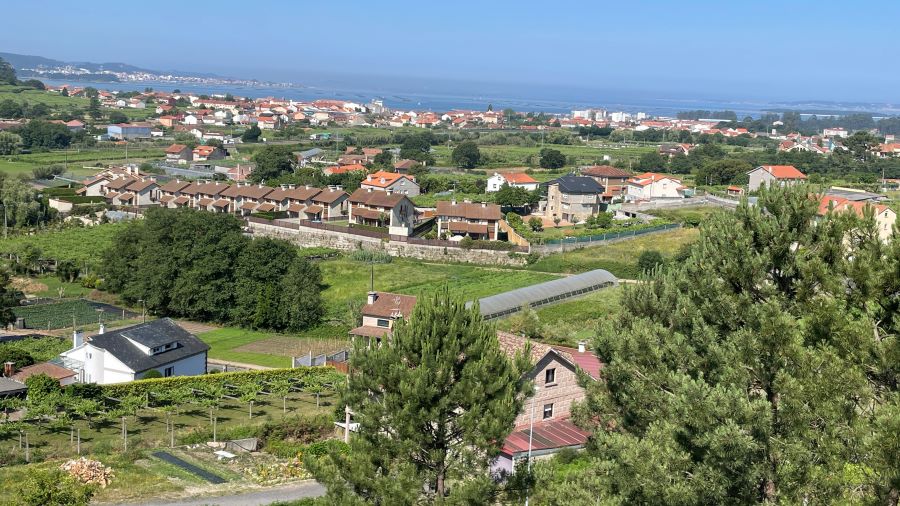
What’s on Offer – Tours and tastings are available Monday-Saturday 10-2pm and 5-8pm, and include background on the winery, vineyards, plenty of distant views of the town of Cambados and ocean, visits to the barrel cave and a tasting on the terrace. There is an option on the website to add Galician cheeses or conservas (typical Galician canned shellfish, molluscs, etc.).
Martin Codax was founded in 1985 and named after a Galician troubadour. They one of the largest cooperative producers in Rías Baixas generating about 125K cases of wine. The coop was founded by 270 winegrowing families and purchases fruit from another 300 farmers. The mission has been to provide research, technical and economic support to the local communities.
Wines – Martin Codax is yet another winery led by a woman winemaker, Katin Alvarez. Evidently, men spent time at sea while women stayed on land and tended crops. Ultimately 50% of the wineries in Rías Baixas are run by women. The winemaking team experiments with lees stirring, whole cluster fermentation, concrete egg and oak storage. The result is a wide range of expressive wines.
Albarino wines range from entry level to premium pricing. They also produce a fine sparkling wine, and an aguardiente digestif liqueur. The entry level priced 2023 Martin Codax Albarino is classic with citrus notes and high acidity. Perfect for pairing with Asian foods.
Bodgas del Palacio de Fefiñanes


Images courtesy Carl Giavanti.
What’s on Offer – Tours and tastings are available by appointment Monday-Saturday 10-2pm and 4pm-8pm. I was surprised to learn that the Bodgas del Palacio de Fefiñanes was on the main square Plaza Fefiñáns in Cambados, across from the Cathedral. I had walked by and admired the stone fortress structure several times, and my GPS directed me there for my appointment. It’s a delight to stroll through and tour. You can imagine what life may have been several hundred years ago behind the stone fortified walls. The visit is another opportunity to tie in a lunch break, as Bar Laya (mentioned below) is directly across the street and has outdoor patio seating.
The winery has been in the family of Don Juan Gil de Araújo for over 100 years, and is located in the heart of Cambados occupying half of the Plaza Fefiñáns, the main plaza. Originally founded in the 17th century as a palace, in 1928 they produced one of the first white wines in RB to have a commercial label. The coat of arms is displayed prominently on the palace walls and wine bottles reminding us of a long and noble history.

Wines – about 15K cases of premium Albariño are produced annually. The 2023 Albarino de Fefiñanes is their flagship and sets the high bar for the other three premium wines you’ll taste.
Pazo Senorans



Images courtesy Carl Giavanti.
What’s on Offer – Tours and tastings are available Monday-Friday by appointment. Guided tours include visiting the manor house, winery, vineyards and outdoor event spaces. You’ll taste at least three wines and two aguardientes (distilled beverages). Contact the winery by email to schedule your group visit.
Looking for a destination wedding venue? Pazo Senorans is your place. Invite me as a token of your appreciation, please.
This is yet another 16th century Galician manor house, converted into a working winery and museum. It’s a fascinating tour to take with all the components of classic country mansions – stone granary, pigeonary, chapel, raised pergolas, palm trees, and historic winery facilities including an original crush pad. The modern-day winery was founded in 1979 with a first vintage in 1989. They farm over 400 different vineyards, both estate and sourced grapes, and today produce about 300K cases of wine exported to 45 countries including the U.S.
Wines – 100% of all wines and distilled beverages produced by Pazo Senorans are from the Albariño grape. I tasted and enjoyed a range of styles and for my palate loved the flagship Pazo Senorans Albariño. Five months of lees stirring in stainless steel yielded a full-bodied acid driven wine with aromas of green apples and citrus with a touch a salinity. Perfect pairing with any local seafood or fish stew.
Galician Seafood




Images courtesy Carl Giavanti.
I know, you’ve heard it before, but what grows together really does go together. Albariño wines have signature notes of citrus, stone fruit, and briny minerality. You can therefore easily imagine how well these whites must pair with seafood from the region of Galicia — fresh seafood including mussels, prawns, hearty stews, and artisanal cheeses. I rarely pass up a chance to enjoy grilled octopus, in this region you should order “pulpo a la gallega” (Galician-style octopus), alongside a glass of just about any Albariño. The freshness of the octopus works so well with the crisp acidity and saline finish of the wine.
Dining in Cambados
Taberna do Calzada
12pm-4:30pm and 7pm-11:30pm
Outdoor bar with waterfront seating with value priced wines and tapas.
Restaurante Divinas Palabras
Near Plaza de Fefiñans. 11am-1am Daily.
Go for the razor clams, mussels, scallops and pulpo (octopus). And then go again.
Pub a Leria
Open Daily 8:30am-1:30am
Fun soccer pub away from the waterfront. Great for beers, inexpensive wines and tapas. Find out when any local or national matches being broadcast.
Bar Laya
10am-12am Daily
Great for lunch on the plaza, across from the Cathedral. Open 10am-12am.
Try the Pimiento de Padron (roasted peppers), jamon y queso (ham & cheese platter) and empanadas casera (homemade empanadas, often with tuna or other fin fish).
A Fonte do Viño
Daily lunch 1-4pm and dinner 8-11pm. Closed Tuesday.
This is the one “Plate” Michelin Restaurant where I met my eating match. A Fonte is an oyster farm specializing in local seafood and has a private wine label “Pepa a Loba” Albariño worth trying.
Granbazán Winery
Open for lunch Tuesday-Saturday. Contact the winery for lunch reservations.
Fine dining restaurant in an historic blue tiled chateaux.
O Casal Restaurante
12:30-4:30pm and 7:30pm to 12am.
Try the empanadas of crab, barnacle and roast chestnut pate’, pulpo a la gallega or feira, razor clams and langostina gyoza.
More Great Things To Do in Rías Baixas
The Albariño Wine Festival is one of the oldest food and wine festivals in Spain, and takes place in Cambados every first weekend of August. This festival was founded in 1953, and was originally a winemaker’s competition. It is now considered one of the year’s most important international tourist events in Rias Baixas. Learn more about the events and all the festivities here.
The Cambados Wine Museum was built on a 5th century ruin site, and was the first museum of its type in Spain. You can learn the history of wine, grape growing, art and culture of the region. Open Daily. 1 Euro. 1 hour is ideal. Check the website for seasonal schedule.
Visit the Pazos. Galician manor houses have rich history as described in this article. They are still worth visiting even if you’ve tired or wine tasting (for shame 😉 History, history, history of nobility including viscounts with coats of arms, palaces, manor houses with chapels, dovecotes (pigeon houses), palm trees, elevated granary (stone grain storage sheds), and of course, wine cellars. There are 500 years of history to discovery and buildings as impressive as the castles and forts of Loire, France. Some Pazos have museums and the grounds are open and available to stroll. I suggest research first and turn up at the office or tasting room and ask permission to wander, explaining you won’t be tasting wines today.
The Parador of Cambados is an historic hostel-hotel run by the local government. They offer high tea, drinks on the terrace, and a fine dining restaurant.
Vinoteca El Principe is a wine bar worth a visit in the waterfront area of Cambados. They have a large selection of local Albariño at reasonable prices. The owner is from Madrid and a serious fan of Real Madrid. Go there to talk soccer and wine.
You are reading “Travel Guide to Wine Tasting in Spain’s Rías Baixas Wine Region:” Back To Top
For other wineries and itineraries: read our wine tasting travel guide to Spain
If you enjoyed this guide, consider joining the Facebook Group to interact with other Winetravelers and for wine travel inspiration worldwide. Be sure to follow us on X (formerly Twitter) and Instagram to stay updated with our trending content.
